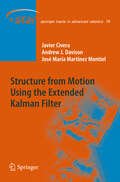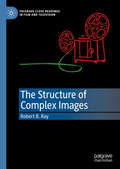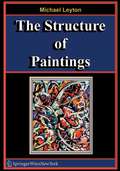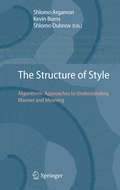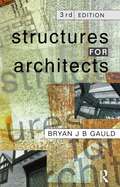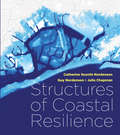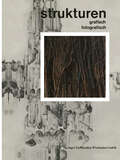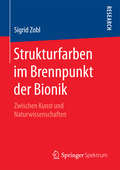- Table View
- List View
Structure for Architects: A Primer
by Ramsey Dabby Ashwani BediAn introduction to the concepts and principles of architectural structures in an easy-to-read format Written as an easy-to-understand primer on the topic, Structure for Architects engages readers through instruction that uses a highly visual format and real-world examples to underline the key facets of structural principles that are essential to the design process. Eschewing complicated mathematics and technical jargon, Structure for Architects demystifies the subject matter by showing it in the context of everyday situations, giving architects and architectural technologists a clear understanding of how to incorporate structural principles into their designs. Highlights of this book include: A rich collection of drawings, photographs, and diagrams, spread throughout the text, which demonstrate fundamental structural concepts using everyday examples An overview of structural design basics, as well as a summary of structural forms A look at the design implications of steel, reinforced concrete, and wood By providing an overall view of structures that covers the essentials of what architects and architectural technologists need to know, Structure for Architects is a valuable tool for illustrating the importance of designing with structure in mind and for learning the basics that are necessary for collaborating confidently with project team members.
Structure from Motion using the Extended Kalman Filter (Springer Tracts in Advanced Robotics #75)
by Javier Civera Andrew J. Davison José María Martínez MontielThe fully automated estimation of the 6 degrees of freedom camera motion and the imaged 3D scenario using as the only input the pictures taken by the camera has been a long term aim in the computer vision community. The associated line of research has been known as Structure from Motion (SfM). An intense research effort during the latest decades has produced spectacular advances; the topic has reached a consistent state of maturity and most of its aspects are well known nowadays. 3D vision has immediate applications in many and diverse fields like robotics, videogames and augmented reality; and technological transfer is starting to be a reality. This book describes one of the first systems for sparse point-based 3D reconstruction and egomotion estimation from an image sequence; able to run in real-time at video frame rate and assuming quite weak prior knowledge about camera calibration, motion or scene. Its chapters unify the current perspectives of the robotics and computer vision communities on the 3D vision topic: As usual in robotics sensing, the explicit estimation and propagation of the uncertainty hold a central role in the sequential video processing and is shown to boost the efficiency and performance of the 3D estimation. On the other hand, some of the most relevant topics discussed in SfM by the computer vision scientists are addressed under this probabilistic filtering scheme; namely projective models, spurious rejection, model selection and self-calibration.
The Structure of Complex Images (Palgrave Close Readings in Film and Television)
by Robert B. RayAfter over a century of existence, the cinema still has its mysteries. Why, for example, is the job we call movie stardom unlike any other in the world? How do films provide so much unconcealed information that we fail to notice? What makes it hard to define what counts as “acting”? How do movies like Casablanca and Breathless store the film and world histories of their generations? How can we reconcile auteurism’s celebration of the movie director’s authority with the camera’s automatism? Why have the last four decades of film criticism so often neglected such questions? After beginning with an overview of film studies, this book proposes a shift from predictable theoretical approaches to models that acknowledge the perplexities and mysteries of the movies. Deriving methods from cinephilia, Wittgenstein, Richard Rorty, Stanley Cavell, Eleanor Duckworth, V. F. Perkins, and James Naremore, Robert B. Ray offers close readings that call attention to what we have missed in such classic films as La Règle du Jeu, It Happened One Night, It’s a Wonderful Life, Vertigo, Holiday, The Philadelphia Story, Casablanca, Breathless, and Tickets.
The Structure of Paintings
by Michael LeytonMichael Leyton has developed new foundations for geometry in which shape is equivalent to memory storage. A principal argument of these foundations is that artworks are maximal memory stores. The theory of geometry is developed from Leyton's fundamental laws of memory storage, and this book shows that these laws determine the structure of paintings. Furthermore, the book demonstrates that the emotion expressed by a painting is actually the memory extracted by the laws. Therefore, the laws of memory storage allow the systematic and rigorous mapping not only of the compositional structure of a painting, but also of its emotional expression. The argument is supported by detailed analyses of paintings by Picasso, Raphael, Cezanne, Gauguin, Modigliani, Ingres, De Kooning, Memling, Balthus and Holbein.
The Structure of Style: Algorithmic Approaches to Understanding Manner and Meaning
by Shlomo Argamon Kevin Burns Shlomo DubnovStyle is a fundamental and ubiquitous aspect of the human experience: Everyone instantly and constantly assesses people and things according to their individual styles, academics establish careers by researching musical, artistic, or architectural styles, and entire industries maintain themselves by continuously creating and marketing new styles. Yet what exactly style is and how it works are elusive: We certainly know it when we see it, but there is no shared and clear understanding of the diverse phenomena that we call style. The Structure of Style explores this issue from a computational viewpoint, in terms of how information is represented, organized, and transformed in the production and perception of different styles. New computational techniques are now making it possible to model the role of style in the creation of and response to human artifacts—and therefore to develop software systems that directly make use of style in useful ways. Argamon, Burns, and Dubnov organize the research they have collected in this book according to the three roles that computation can play in stylistics. The first section of the book, Production, provides conceptual foundations by describing computer systems that create artifacts—musical pieces, texts, artworks—in different styles. The second section, Perception, explains methods for analyzing different styles and gleaning useful information, viewing style as a form of communication. The final section, Interaction, deals with reciprocal interaction between style producers and perceivers, in areas such as interactive media, improvised musical accompaniment, and game playing. The Structure of Style is written for researchers and practitioners in areas including information retrieval, computer art and music, digital humanities, computational linguistics, and artificial intelligence, who can all benefit from this comprehensive overview and in-depth description of current research in this active interdisciplinary field.
Structures: From Theory to Practice
by Alan JenningsUsing aspects of structural behaviour, good design practice and effective computational techniques to illustrate the importance of the fundamental theoretical concepts presented, this book provides a comprehensive introduction to the analysis and design of structures. The over-riding importance of equilibrium is emphasized and, together with related topics, is the subject of the first five chapters. After deflections have been introduced in chapter six, elastic theory, buckling, plastic theory and energy methods are all introduced and their range of applicability discussed. Numerous case studies are included to help readers gain an appreciation of how theory relates in practice to real life structures. With a broad range of worked examples, questions and references to further reading, Structures is the ideal course text for entry-level students on degree, HNC and HND courses.
Structures and Construction in Historic Building Conservation (Historic Building Conservation)
by Michael ForsythThis book is the second in a series of volumes that combine conservation philosophy in the built environment with knowledge of traditional materials, and structural and constructional conservation techniques and technology: Understanding Historic Building Conservation Structures & Construction in Historic Building Conservation Materials & Skills for Historic Building Conservation The series aims to introduce each aspect of conservation and to provide concise, basic and up-to-date knowledge for architects, surveyors and engineers as well as for commissioning client bodies, managers and advisors. In each book, Michael Forsyth draws together chapters by leading architects, structural engineers and related professionals to reflect the interdisciplinary nature of conservation work. The books are structured to be of direct practical application, taking the reader through the process of historic building conservation and emphasising throughout the integrative teamwork involved. This present volume – Structures & Construction in Historic Building Conservation - traces the history of structures in various materials and contains guidance on the survey, assessment and diagnosis of structures and the integration of building code requirements within the historic fabric. It discusses conservation engineering philosophy, exposes the conflict between building codes and conservation legislation, and offers solutions. Leading-edge, on-site metric survey techniques are described and a range of structural advice is given, including methods of repair in relation to philosophical principles. Causes of induced movement in historic buildings are explained, together with basic soil mechanics and the assessment and diagnosis of structural failure. Chapters also cover the conservation of different types of construction: masonry, iron and steel, and concrete and reinforced concrete. Fourteen chapters written by the experts present today's key issues in structures and construction for historic building conservation: Bill Blake, Michael Bussell, David Cook, Dina F. D'Ayala, Steve Emery, Michael Forsyth, Ian Hume, Peter Norris
Structures by Design: Thinking, Making, Breaking
by Rob WhiteheadStructures by Design: Thinking, Making, Breaking is a new type of structures textbook for architects who prefer to learn using the hands-on, creative problem-solving techniques typically found in a design studio. Instead of presenting structures as abstract concepts defined by formulas and diagrams, this book uses a project-based approach to demonstrate how a range of efficient, effective, and expressive architectural solutions can be generated, tested, and revised. Each section of the book is focused on a particular manner by which structural resistance is provided: Form (Arches and Cables), Sections (Beams, Slabs, and Columns), Vectors (Trusses and Space Frames), Surfaces (Shells and Plates), and Frames (Connections and High-Rises). The design exercises featured in each chapter use the Think, Make, Break method of reiterative design to develop and evaluate different structural options. A variety of structural design tools will be used, including the human body, physical models, historical precedents, static diagrams, traditional formulae, and advanced digital analysis. The book can be incorporated into various course curricula and studio exercises because of the flexibility of the format and range of expertise required for these explorations. More than 500 original illustrations and photos provide example solutions and inspiration for further design exploration.
Structures by Design: Thinking, Making, Breaking
by Rob WhiteheadStructures by Design: Thinking, Making, Breaking is a new type of structures textbook for architects who prefer to learn using the hands-on, creative problem-solving techniques typically found in a design studio. Instead of presenting structures as abstract concepts defined by formulas and diagrams, this book uses a project-based approach to demonstrate how a range of efficient, effective, and expressive architectural solutions can be generated, tested, and revised. Each section of the book is focused on a particular manner by which structural resistance is provided: Form (Arches and Cables), Sections (Beams, Slabs, and Columns), Vectors (Trusses and Space Frames), Surfaces (Shells and Plates), and Frames (Connections and High-Rises). The design exercises featured in each chapter use the Think, Make, Break method of reiterative design to develop and evaluate different structural options. A variety of structural design tools will be used, including the human body, physical models, historical precedents, static diagrams, traditional formulae, and advanced digital analysis. The book can be incorporated into various course curricula and studio exercises because of the flexibility of the format and range of expertise required for these explorations. More than 500 original illustrations and photos provide example solutions and inspiration for further design exploration.
Structures for Architects
by Bryan J.B. GauldDemand from building control officials for structural calculations - even for very simple projects - means that today's architects must have a thorough understanding of everyday structural concepts.Structures for Architects satisfies the need for a basic introduction to the structural problems encountered by the architect, surveyor and builder. This third edition reflects advances in recent techniques and refers to current Building Regulations and Codes of Practice.Students of architecture, building and surveying at degree, diploma or professional (RIBA, RICS, CIOB) examination level will find this book a valuable course text. Professionals in these fields who must perform structural calculations to satisfy building control authorities will also find it a useful handbook.
Structures for Architects
by Bryan J.B. GauldDemand from building control officials for structural calculations - even for very simple projects - means that today's architects must have a thorough understanding of everyday structural concepts.Structures for Architects satisfies the need for a basic introduction to the structural problems encountered by the architect, surveyor and builder. This third edition reflects advances in recent techniques and refers to current Building Regulations and Codes of Practice.Students of architecture, building and surveying at degree, diploma or professional (RIBA, RICS, CIOB) examination level will find this book a valuable course text. Professionals in these fields who must perform structural calculations to satisfy building control authorities will also find it a useful handbook.
Structures of Coastal Resilience
by Catherine Seavitt Nordenson Guy Nordenson Julia ChapmanStructures of Coastal Resilience presents new strategies for creative and collaborative approaches to coastal planning for climate change. In the face of sea level rise and an increased risk of flooding from storm surge, we must become less dependent on traditional approaches to flood control that have relied on levees, sea walls, and other forms of hard infrastructure. But what are alternative approaches for designers and planners facing the significant challenge of strengthening their communities to adapt to uncertain climate futures?Authors Catherine Seavitt Nordenson, Guy Nordenson, and Julia Chapman have been at the forefront of research on new approaches to effective coastal resilience planning for over a decade. In Structures of Coastal Resilience, they reimagine how coastal planning might better serve communities grappling with a future of uncertain environmental change. They encourage more creative design techniques at the beginning of the planning process, and offer examples of innovative work incorporating flexible natural systems into traditional infrastructure. They also draw lessons for coastal planning from approaches more commonly applied to fire and seismic engineering. This is essential, they argue, because storms, sea level rise, and other conditions of coastal change will incorporate higher degrees of uncertainty—which have traditionally been part of planning for wildfires and earthquakes, but not floods or storms.This book is for anyone grappling with the immense questions of how to prepare communities to flourish despite unprecedented climate impacts. It offers insights into new approaches to design, engineering, and planning, envisioning adaptive and resilient futures for coastal areas.
Structures: A Studio Approach
by Edmond SaliklisUnderstanding how gravity loads and wind and earthquake loads flow through a building is of utmost importance to all structural engineers and architects. Paradoxically, this critical idea is practically not addressed in any textbook on the market. Meant as a companion to the author’s Structures: A Geometric Approach, this textbook fills that need with qualitative techniques as well as quantitative tools that use state of the art visual representation of forces and deformations in structures. Structures: A Studio Approach reaches out to both structural engineers and designers by presenting structural engineering topics in an interdisciplinary studio environment. Using many graphical techniques, it offers a very rigorous approach, but also enables creativity. Cutting edge finite element as well as parametric modeling tools are used, and state of the art visual representations of force flow help both groups of students realize that understanding three dimensional load flow in a building is a requirement for channeling that flow in a structurally efficient and visually expressive manner. Ultimately, the reader is able to develop a unique structural sensibility; an ethos that places structural design on an equal footing with the design of program, skin, massing and site.
The Struggle for Jerusalem's Holy Places
by Wendy Pullan Maximilian Sternberg Lefkos Kyriacou Craig Larkin Michael DumperThe Struggle for Jerusalem’s Holy Places investigates the role of architecture and urban identity in relation to the political economy of the city and its wider state context seen through the lens of the holy places. Reflecting the broad disciplinary backgrounds of the authors, this book provides perspectives from architecture, urbanism, and politics, and provides in-depth investigations of historical, ethnographic and policy-related case studies. The research is substantiated by fieldwork carried out in Jerusalem over the past ten years as part of the ESRC Large Grants project ‘Conflict in Cities’. By analysing new dynamics of radicalisation through land seizure, the politicisation of parklands and tourism, the strategic manipulation of archaeological and historical narratives and material culture, and through examination of general appropriation of Jerusalem’s varied rituals, memories and symbolism for factional uses, the book reveals how possibilities of co- existence are seriously threatened in Jerusalem. Shedding new light on the key role played by everyday urban life and its spatial settings for any future political agreements about the city and its religious sites, this book is a useful reference work for students and scholars of Middle East Studies, Architecture, Religion and Urban Studies.
The Struggle for Jerusalem's Holy Places
by Wendy Pullan Maximilian Sternberg Lefkos Kyriacou Craig Larkin Michael DumperThe Struggle for Jerusalem’s Holy Places investigates the role of architecture and urban identity in relation to the political economy of the city and its wider state context seen through the lens of the holy places. Reflecting the broad disciplinary backgrounds of the authors, this book provides perspectives from architecture, urbanism, and politics, and provides in-depth investigations of historical, ethnographic and policy-related case studies. The research is substantiated by fieldwork carried out in Jerusalem over the past ten years as part of the ESRC Large Grants project ‘Conflict in Cities’. By analysing new dynamics of radicalisation through land seizure, the politicisation of parklands and tourism, the strategic manipulation of archaeological and historical narratives and material culture, and through examination of general appropriation of Jerusalem’s varied rituals, memories and symbolism for factional uses, the book reveals how possibilities of co- existence are seriously threatened in Jerusalem. Shedding new light on the key role played by everyday urban life and its spatial settings for any future political agreements about the city and its religious sites, this book is a useful reference work for students and scholars of Middle East Studies, Architecture, Religion and Urban Studies.
The Struggle for Utopia: Rodchenko, Lissitzky, Moholy-Nagy, 1917-1946
by Victor MargolinFollowing World War I, a new artistic-social avant-garde emerged with the ambition to engage the artist in the building of social life. Through close readings of the works of Alexander Rodchenko, El Lissitzky, and László Moholy-Nagy whose careers covered a broad range of artistic practices and political situations, Victor Margolin examines the way these three artists negotiated the changing relations between their social ideals and the political realities they confronted. Focusing on the difficult relationship between art and social change, Margolin brings important new insights to the understanding of the avant-garde's role in a period of great political complexity. "An ambitious effort. This book puts the masters of European Modernism into perfect focus as inventors, propagators, and practitioners of a visual language that continues to hold sway over contemporary graphic style."—Steven Heller "Worth the wait. . . . Margolin usefully presents what he calls the 'failed hope' of this movement in this valuable effort."—Publishers Weekly
Strukturen Grafisch | Fotografisch: 20 Farbfotos Italienischer Maler 25 Strukturstudien Junger Grafiker
by Hermann SchardtWir leben im Zeitalter der Internationalen Partnerschaften. Poli tische, kulturelle, wirtschaftliche Interessengemeinschaften werden ins Leben gerufen, gepflegt und gefördert. Es besteht immer und trotz aller bedrängenden Geschehnisse die berechtigte Hoffnung, daß über die Narben der Geschichte: über die Staatsgrenzen hinaus eine wahre Union die Völker verbinden wird. So mag auch das vorliegende Buch in einem bestimmten Sinne als ein beschei dener Beitrag zu dieser erstrebenswerten Entwicklung gedeutet werden. Bekannte Italienische Künstler folgten einer Anregung der Ferrania, Malland, des italienischen Weltunternehmens auf dem Gebiete der Fotografie, und suchten durch das Objektiv der Kamera und die Mittel der Farbfotografie in der Natur und in den Dingen jene Ord nungsgefüge neu zu entdecken, denen sie sonst aus Innerer Sicht mit den Ausdrucksmitteln des Malers Gestalt verleihen. Die gefun denen Strukturen legen Zeugnis ab über ihr Beobachtungsver mögen und vermitteln zugleich einen Eindruck Ihrer Vorstellungs weit. Sie weisen auch auf Möglichkeiten der Farbfotografie hin, die einen weiten Spielraum bieten. 5 Diesen Farbfotos stehen Studienarbeiten gegenüber, die an der Folkwangschule für Gestaltung, Essen, aus einer gewissenhaften und ins kleinste Detail gehenden Beobachtung stofflicher Struk turen entstanden sind. Nach Möglichkeit wurde Wert darauf gelegt, den Besonderheiten dieser Zeichnungen durch Wiedergabe in Originalgröße gerecht zu werden. Für den geneigten Betrachter möge diese Symbiose von Technik und kreativem Humanum, wie sie in den folgenden Blättern sichtbar wird, als Anregung wirksam werden, den Reichtum der Sprache der Naturformen in bildnerischen Zeugnissen junger deutscher und bekannter italienischer Künstler zu erleben.
Strukturfarben im Brennpunkt der Bionik: Zwischen Kunst und Naturwissenschaften
by Sigrid ZoblSigrid Zobl beschreibt eine low-tec-high-yield-Abformmethode für synthetische und organische Oberflächen, die schnell, kostengünstig, mit wenig Materialaufwand und ohne aufwändiges Equipment durchführbar ist, um Strukturfarben und eventuell ihre Funktionen zu replizieren. Die im Rahmen dieser Arbeit abgeformten 22 organischen Vorlagen stammen aus der Gruppe der Flora und Fauna. Die Autorin zeigt, dass CD-R-Positiv-Abdrücke nicht nur einen direkten Anwendungsbereich als künstlerisches Stilmittel liefern, sondern dass die positiven Epoxidharz-Abdrücke auch zur Anlage einer Datenbank für biomimetische Oberflächen dienen können. Darüber hinaus liefern die Abdrücke neue Erkenntnisse für die Grundlagenforschung.
Stuart Academic Drama: An Edition of Three University Plays (Routledge Library Editions: Renaissance Drama)
by David L. RussellAlthough not much is known about the three Stuart plays in this edition, which was first published in 1987, we can ascribe them to one of the English universities, and each is indicative of a distinctly different influence on the Renaissance academic drama. Heteroclitanomalonomia is part of a minor subgenre referred to as the academic play. It demonstrates the predominance of language or rhetoric studies in the period and its very subject is of purely academic interest. Gigantomachia displays the continuing interest of the Renaissance in classical mythology. And A Christmas Messe follows a more homely tradition, a farcical personification of the mundane. This title will be of interest to students of English Literature, Drama and Performance.
Stuart Academic Drama: An Edition of Three University Plays (Routledge Library Editions: Renaissance Drama)
by David L. RussellAlthough not much is known about the three Stuart plays in this edition, which was first published in 1987, we can ascribe them to one of the English universities, and each is indicative of a distinctly different influence on the Renaissance academic drama. Heteroclitanomalonomia is part of a minor subgenre referred to as the academic play. It demonstrates the predominance of language or rhetoric studies in the period and its very subject is of purely academic interest. Gigantomachia displays the continuing interest of the Renaissance in classical mythology. And A Christmas Messe follows a more homely tradition, a farcical personification of the mundane. This title will be of interest to students of English Literature, Drama and Performance.
Stuart Hall: Critical Dialogues in Cultural Studies
by Kuan-Hsing Chen David MorleyStuart Hall's work has been central to the formation and development of cultural studies as an international discipline. Stuart Hall: Critical Dialogues in Cultural Studies is an invaluable collection of writings by and about Stuart Hall. The book provides a representative selection of Hall's enormously influential writings on cultural studies and its concerns: the relationship with Marxism; postmodernism and 'New Times' in cultural and political thought; the development of cultural studies as an international and postcolonial phenomenon, and Hall's engagement with urgent and abiding questions of 'race', ethnicity and identity.In addition to presenting classic writings by Hall and new interviews with Hall in dialogue with Kuan-Hsing Chen, the collection, which includes work by Angela McRobbie, Kobena Mercer, John Fiske, Charlotte Brunsdon, Ien Ang and Isaac Julien, provides a detailed analysis of Hall's work and his contribution to the development of cultural studies by leading cultural critics and cultural practitioners. The book also includes a comprehensive bibliography of Stuart Hall's writings.
Stuart Hall: Critical Dialogues in Cultural Studies
by Kuan-Hsing Chen David MorleyStuart Hall's work has been central to the formation and development of cultural studies as an international discipline. Stuart Hall: Critical Dialogues in Cultural Studies is an invaluable collection of writings by and about Stuart Hall. The book provides a representative selection of Hall's enormously influential writings on cultural studies and its concerns: the relationship with Marxism; postmodernism and 'New Times' in cultural and political thought; the development of cultural studies as an international and postcolonial phenomenon, and Hall's engagement with urgent and abiding questions of 'race', ethnicity and identity.In addition to presenting classic writings by Hall and new interviews with Hall in dialogue with Kuan-Hsing Chen, the collection, which includes work by Angela McRobbie, Kobena Mercer, John Fiske, Charlotte Brunsdon, Ien Ang and Isaac Julien, provides a detailed analysis of Hall's work and his contribution to the development of cultural studies by leading cultural critics and cultural practitioners. The book also includes a comprehensive bibliography of Stuart Hall's writings.
Stuart Women Playwrights, 1613–1713
by Pilar Cuder-DominguezIn the field of seventeenth-century English drama, women participated not only as spectators or readers, but more and more as patronesses, as playwrights, and later on as actresses and even as managers. This study examines English women writers' tragedies and tragicomedies in the seventeenth century, specifically between 1613 and 1713, which represent the publication dates of the first original tragedy (Elizabeth Cary's The Tragedy of Mariam) and the last one (Anne Finch's Aristomenes) written by a Stuart woman playwright. Through this one-hundred year period, major changes in dramatic form and ideology are traced in women's tragedies and tragicomedies. In examining the whole of the century from a gender perspective, this project breaks away from conventional approaches to the subject, which tend to establish an unbridgeable gap between the early Stuart period and the Restoration. All in all, this study represents a major overhaul of current theories of the evolution of English drama as well as offering an unprecedented reconstruction of the genealogy of seventeenth-century English women playwrights.
Stuart Women Playwrights, 1613–1713
by Pilar Cuder-DominguezIn the field of seventeenth-century English drama, women participated not only as spectators or readers, but more and more as patronesses, as playwrights, and later on as actresses and even as managers. This study examines English women writers' tragedies and tragicomedies in the seventeenth century, specifically between 1613 and 1713, which represent the publication dates of the first original tragedy (Elizabeth Cary's The Tragedy of Mariam) and the last one (Anne Finch's Aristomenes) written by a Stuart woman playwright. Through this one-hundred year period, major changes in dramatic form and ideology are traced in women's tragedies and tragicomedies. In examining the whole of the century from a gender perspective, this project breaks away from conventional approaches to the subject, which tend to establish an unbridgeable gap between the early Stuart period and the Restoration. All in all, this study represents a major overhaul of current theories of the evolution of English drama as well as offering an unprecedented reconstruction of the genealogy of seventeenth-century English women playwrights.
Stud: Architectures of Masculinity (Routledge Revivals)
by Joel SandersOriginally published in 1996, Stud: Architectures of Masculinity is an interdisciplinary exploration of the active role architecture plays in the construction of male identity. Architects, artists, and theorists investigate how sexuality is constituted through the organization of materials, objects, and human subjects in actual space. This collection of essays and visual projects critically analyzes the spaces that we habitually take for granted but that quietly participates in the manufacturing of "maleness." Employing a variety of critical perspectives (feminism, "queer theory," deconstruction, and psychoanalysis), Stud's contributors reveal how masculinity, always an unstable construct, is coded in our environment. Stud also addresses the relationship between architecture and gay male sexuality, illustrating the resourceful ways that gay men have appropriated and reordered everyday public domains, from streets to sex clubs, in the formation of gay social space.

